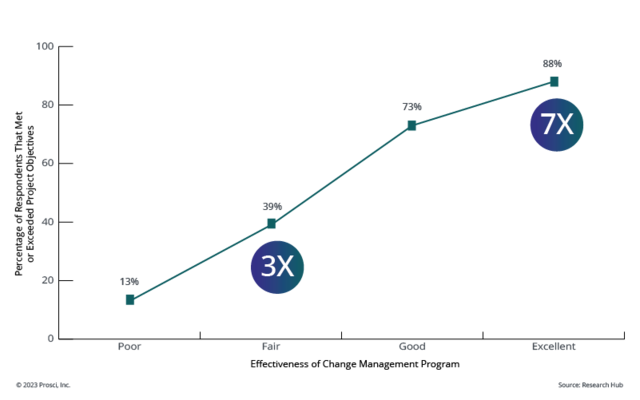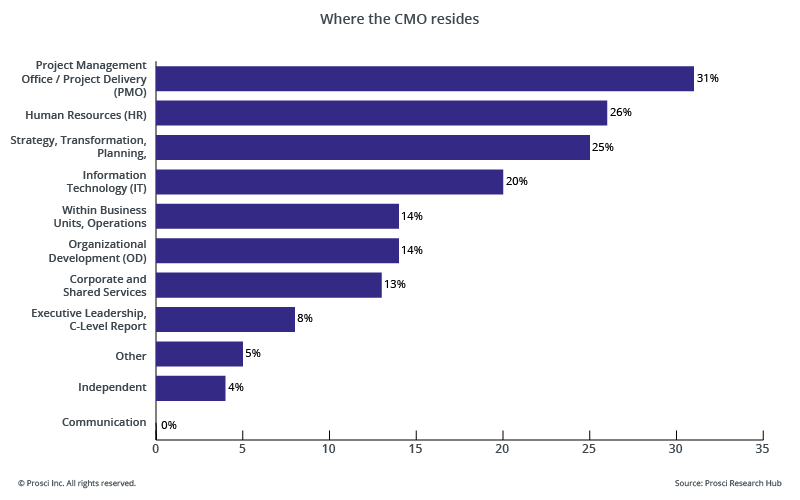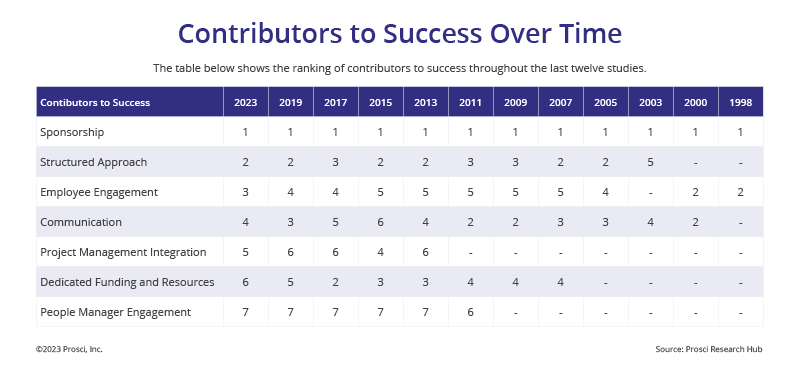What happens if you install a new LMS that students and faculty refuse to adopt and use? What if employees in finance develop a manual workaround for the new multi-million-dollar ERP system? What if you implement new course scheduling systems and not all units participate? Any significant, high-risk change that depends on people adopting and using it needs effective change management to be successful. Because institutions don’t change—people do.
Critical Changes to Manage in Higher Ed Today
According to a recent Educause poll on adapting to change and disruption, 69% of respondents in higher education said their institution continued to experience a great deal or some change and disruption. Disruptions range from staffing challenges and flexible work arrangements to outdated technologies and falling enrollments.
Although implementing any change comes with unique challenges, projects that have the most significant impacts on the way people do their daily work pose particular risks to the institution’s investments. This is because the success of these changes depends upon people adopting and using new ways of working. And because changes in higher education often impact the day-to-day actions of thousands of staff, faculty, students and stakeholders, the risk of these projects failing outright can’t be understated.
Although any change can pose challenges to people, these six challenges are particularly complex and dependent on adoption to succeed:
-
Process changes are common in higher education today, especially with IT systems changes. Some are very large in size and scope, such as installing a customer relationship management (CRM) system or transitioning to a new enterprise resource planning (ERP) system across multiple colleges or departments, or entire university system. Other process changes are smaller, like integration of tools and resources, or an academic technology that is specific to one college. Regardless, process changes impact many aspects of a person’s job—from job roles and responsibilities to workflows and tools.
%20(1).jpg?width=600&height=323&name=10-Aspects-Change-Impact-Model-150%20(2)%20(1).jpg)
-
Data governance in higher education is critical. Do we have the same language? Do we have shared definitions? Are we storing data in a consistent manner? Who owns the data? Who can access the data? Who can generate reports versus react to reports? The data governance component is another big part of the complexity of managing changes in higher education, and data governance drives additional process changes to manage, impacting systems, tools, job roles, mindsets, and more.
-
Regulatory changes affect institutions far more broadly than it seems. For example, a regulatory change from the US Department of Education on third-party partnerships impacts the outsourcing of different operations to support and deliver services and programs. Changes in financial aid application process—the FAFSA (Free Application for Federal Student Aid) that every student fills out every year—impact the ways institutions must collect, store and manage personal information and tax data from students and parents. Regional, state, and programmatic accreditation requirements drive changes broadly across the institution and within specific programs. Institutions need to understand and address all these ripples and plan carefully to ensure that people are equipped to perform their jobs the day the regulatory changes go into effect. Failure leads to costly rework, incorrect reimbursements, and the loss of students who depend on timely financial aid.
-
Technology impacts nearly every area of higher education. Institutions leveraging outdated or homegrown IT infrastructures and systems experience challenges, which inhibit their ability to scale. Those without online offerings before the pandemic found quick ways to add online offerings by building or buying tools to host them—and now the systems and processes to be formalized. And accessibility issues need to be addressed in face-to-face and virtual delivery. Overall, institutions need to find balance between using SaaS integrated IT services, third-party provided services, and homegrown efforts. These decisions provide many choices, and drive changes to people’s jobs and reporting structures, systems and processes, tools, critical behaviors, and work locations.

-
Course planning includes changes that enable coursework and degree completion, such as updates to registration systems and creating student pathways to graduation. Design and delivery of instructional content also involves changes like enabling virtual lab work or installing a learning management system (LMS) to house curricular assets and facilitate asynchronous student conversations. In addition to impacts on systems and processes, changes to course planning have huge impacts on mindsets and beliefs. People need functional training, as well as support throughout the transition, to ensure that they have the skills and mindset needed to bring the change to life and then sustain it without developing workarounds.
-
Data and cybersecurity issues drive ongoing cross-functional changes. Declining enrollments and the need to offer online programs is accelerating changes that keep institutions relevant, attract students, and maintain market share. Leveraging data-driven insights enables institutions to make better business decisions, such as identifying programs with the potential for high return on investment (ROI), understanding marketing conversion rates, or simply understanding what activities no longer align with the institution’s vision. Cybersecurity also generates ongoing, top-priority changes to protect institutions. And because cybersecurity is everybody’s job today, it can’t be relegated to the IT department. We really need to help people change behaviors and adopt new tools to be successful.
Why Higher Ed
Needs Change Management
Change management is far more than sending a few communications about the changes and offering functional training on the new tool or process. Change management is an enabling framework for managing the people side of change. It’s the discipline that guides how you prepare, equip and support people who are impacted by these important changes to their daily work.
The benefits of applying change management in higher ed institutions include:
- Preventing and mitigating resistance to change from faculty, staff, students and other stakeholders
- Improving engagement, mitigating negativity and turnover, and enhancing the working experience at your institution
- Delivering the people-dependent portion of ROI on your must-win projects and initiatives
- Mitigating costs and risks from project rework and failure
- Minimizing change saturation and fatigue, and avoiding project collisions within your portfolio of changes
Prosci ‘s 25 years of research on the Best Practices in Change Management represents the largest body of knowledge in the change management discipline. This research shows that projects with effective change management are 7X more likely to meet or achieve objectives than projects with poor change management. Even fair change management correlates with achieving a 3X likelihood of success.

In addition to meeting objectives, our research shows that projects with effective change management correlate with being 5X more likely to stay on schedule and 1.5X more likely to stay within budget.
Actions to Start Addressing
Critical Changes in Higher Ed
The fact that institutions must juggle different types of changes with cross-functional overlap and limited resources adds to the complexity of managing change in higher education and requires more focus on managing the overall portfolio or program of changes to get it right.
Our research consistently shows that having a structured approach to change management is a top contributor to success with change because it enables you to implement multiple changes and scale efficiently while speaking a common language across the institution.
Your institution can start managing important changes more effectively by taking the following steps:
- Work with institutional leaders to get support and commitment for change management
Our research shows that change management expertise lives in many functional areas of institutions, and most commonly in IT, HR, the project management office, and strategic planning office. If you already have change management professionals applying change management on projects in your organization, enlist them to help you present a case to leaders for why change management can benefit your project or initiative and the larger institution by sharing its benefits, how it works, success stories, and its ROI.

- Intentionally build change management capabilities in your teams
Building your institution’s change capabilities enables you to handle more change, faster and more cost-effectively. Every institution is unique. You might start by selecting key members of your team to go through to change management training. If you need to scale and mature quickly in change management, our Change Advisors can help you develop a holistic approach to building capabilities with training, hands-on deployment support, change management consulting, licensing, and other guidance.
- Equip people to perform their unique roles during change
Change management practitioners are equipped to lead your overall change management strategy and planning, but they can’t do it alone. Active and visible sponsorship is the number one success factor in every Best Practices in Change Management research study. Sponsors need coaching to understand what to do, when to do it, and how. People managers are so essential, they play five key roles during change, and they need to develop the right skills. You can support them with coaching, holding meetings to practice new skills, or by hosting a community of practice to share best practices and insights.

Learn More About
Change Management in Higher Ed
Higher education institutions face a wide range of disruptive changes, and change management is essential for managing the people side impacts. By acting today, you can start developing the skillset your people need to lead your institution into this new era of education—one that is steeped in innovation and resilience.





.png)
%20(1).jpg?width=600&height=323&name=10-Aspects-Change-Impact-Model-150%20(2)%20(1).jpg)





